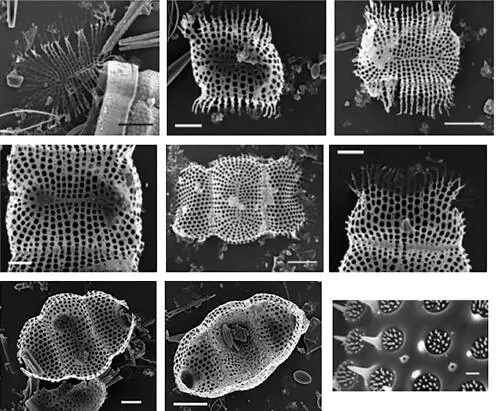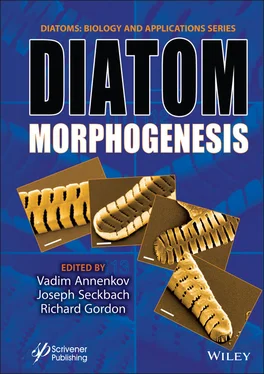Diatom Morphogenesis
Здесь есть возможность читать онлайн «Diatom Morphogenesis» — ознакомительный отрывок электронной книги совершенно бесплатно, а после прочтения отрывка купить полную версию. В некоторых случаях можно слушать аудио, скачать через торрент в формате fb2 и присутствует краткое содержание. Жанр: unrecognised, на английском языке. Описание произведения, (предисловие) а так же отзывы посетителей доступны на портале библиотеки ЛибКат.
- Название:Diatom Morphogenesis
- Автор:
- Жанр:
- Год:неизвестен
- ISBN:нет данных
- Рейтинг книги:5 / 5. Голосов: 1
-
Избранное:Добавить в избранное
- Отзывы:
-
Ваша оценка:
- 100
- 1
- 2
- 3
- 4
- 5
Diatom Morphogenesis: краткое содержание, описание и аннотация
Предлагаем к чтению аннотацию, описание, краткое содержание или предисловие (зависит от того, что написал сам автор книги «Diatom Morphogenesis»). Если вы не нашли необходимую информацию о книге — напишите в комментариях, мы постараемся отыскать её.
A unique book presenting the range of silica structures formed by diatoms, theories and hypotheses of how they are made, and applications to nanotechnology by use or imitation of diatom morphogenesis.
Audience
Diatom Morphogenesis — читать онлайн ознакомительный отрывок
Ниже представлен текст книги, разбитый по страницам. Система сохранения места последней прочитанной страницы, позволяет с удобством читать онлайн бесплатно книгу «Diatom Morphogenesis», без необходимости каждый раз заново искать на чём Вы остановились. Поставьте закладку, и сможете в любой момент перейти на страницу, на которой закончили чтение.
Интервал:
Закладка:

Figure 2.5Three stages of valve formation (as defined in [2.125]) in Biddulphia . Row 1: First stage shows formation of the elongated annulus, branching virgae and vimines producing open holed areolae, and the internal tubes of rimoportulae just beginning. Row 2: Second stage shows the external emergence of rimoportulae, the filling in of areolae, and ridges are more hyaline with increasing silica deposition. Row 3: Third stage shows the beginning of pseudocelli formation, fusing of the valve margin, and the mature cribra. All photos by Mary Ann Tiffany.
Prior to valve formation, mitotic and cytokinetic processes occur [2.122]. Silica aggregation occurs within the silicalemma/SDV where new wall formation occurs [2.59, 2.116, 2.119, 2.126]. The general outline of the cell wall is molded via the plasmalemma [2.122].
As silica deposition occurs from center to the periphery, it is evident that various structures are created at various times in a sequence. Major structures common to all species of a given genus, particular valve structures that are important morphologically, and concavity or undulations associated with the valve face (perhaps due to buckling [2.52]) are associated with symmetries of the diatom valve. The species-specific differences in valve structures and their location and timing of formation are indicators of symmetry changes during valve formation.
Sexual reproduction and auxosporulation result in a cell wall that is similar to a diatom spore and takes a few generations to “restore” the vegetative shape [2.69]. The initial valve that is formed, by an unknown mechanism, morphogenetically determines vegetative valve shape via protoplast adhesion and contraction within the spherical auxospore [2.122, 2.156]. Heterovalvy is apparent even within the initial valve [2.125], having implications for symmetry.
2.2.3 Image Entropy and Symmetry Measurement
Symmetry measurement has been accomplished in a variety of ways. For example, rotational symmetry has been measured as a comparison of equal length five-petalled flowers to pentagons [2.33], point-spread function of optical properties within circular shapes exclusively [2.15], landmarks [2.121] or feature points [2.86] used for intraspecies shape comparison, and cylindrical helical diffraction grid patterns via trigonometric polynomials to measure helices [2.136]. All of these methods are inadequate for measuring symmetry in centric diatoms for a number of reasons. Because symmetry has been primarily applied to the understanding of developmental stability, fitness and adaptation [2.54], measurement needs to reflect the connection among all changes during development and should not be merely a matter of geometric convenience. Centric diatoms exhibit multiple symmetries (Figure 2.3) which necessarily requires a flexible measurement tool. From the spherical auxospore to the variably symmetric initial cell to the rotationally and/or reflective symmetric vegetative cell, different symmetries are expressed throughout the diatom life cycle. The sources of symmetry that contribute to pattern formation include perturbations as symmetry breaking instances to preservation of structural elements throughout development [2.40], and these structural elements may have different symmetries. None of the aforementioned methods have utility in comparing multiple symmetries concurrently or have been used in symmetry measurement for multiple genera or species at the same time. Additionally, these methods are used only in intraspecies shape comparisons without surface feature measurement in symmetry assessment.
Alternatively, a more broad-based methodology is necessary to use in symmetry measurement in centric diatoms. Valve shape and surface feature pattern variation as symmetry changes are measurable simultaneously via the amount of information available in an image. Measurement of information is not reliant on specific geometries or the spatial frequency or position of morphological features or scale. Multiple symmetries may be measured based on available information of shape and surface.
Symmetry may be defined as the micro-states of a macro-state dynamical system of an organism which undergoes morphogenetic, embryogenetic, cytogenetic, epigenetic, or developmental changes. When information is known only about the macro-state, probable micro-states are measures of the lack of this information and what is unknown about the actual micro-states [2.100]. Entropy is a measure of the lack of this information [2.66], and the behavior of symmetry changes is measurable as changes in the amount of information available about the arrangement of and distribution of all symmetry micro-states.
Image processing techniques are useful in characterizing information contained in pixels in digital images. The geometry of a diatom is related to pixel intensities in a digital image, and that geometry can be translated into information about diatom shape and surface features. Image entropy is the amount of compression of an image as it relates to the amount of contrast. Low image entropy indicates that there is low contrast with a lot of similar valued pixels in the image, i.e., black dominates the image, and the image is compressible to a small size. High image entropy indicates that there is high contrast, and the image requires a high amount of compression. Entropy is invariant to translation, rotation and scaling [2.5, 2.70].
Image entropy is  where p is the probability that the difference between adjacent pixels is i and log2 is the base-2 logarithm, if information is measured in bits [2.129]; log2 ( p .) is the amount of uncertainty or information associated with a given outcome.
where p is the probability that the difference between adjacent pixels is i and log2 is the base-2 logarithm, if information is measured in bits [2.129]; log2 ( p .) is the amount of uncertainty or information associated with a given outcome.
In an image, the probable information in gray-level pixels is equated with the state of the gray-level pixels associated with a given outcome. One such outcome is a symmetry state of an ensemble of gray-level pixels. For an image, information as states is calculated as a Boltzmann entropy [2.16–2.18, 2.84], S = -kB\n w , where micro-state w is a symmetry state and kB is the Boltzmann constant [2.16-2.18, 2.84]. For  symmetry states with
symmetry states with  total number of symmetry numbers, log w given by Stirling’s approximation is
total number of symmetry numbers, log w given by Stirling’s approximation is  [2.10, 2.67]. From this, log
[2.10, 2.67]. From this, log  and for
and for  [2.10].
[2.10].
Using the natural logarithm,  ln pi , and with kB = 1, S . = -ln w . for a single ith micro-state [2.84]. Symmetry states and their probable presence are connected in this way. Rearranging the Boltzmann entropy equation results in w = eS [2.66, 2.84].
ln pi , and with kB = 1, S . = -ln w . for a single ith micro-state [2.84]. Symmetry states and their probable presence are connected in this way. Rearranging the Boltzmann entropy equation results in w = eS [2.66, 2.84].
Интервал:
Закладка:
Похожие книги на «Diatom Morphogenesis»
Представляем Вашему вниманию похожие книги на «Diatom Morphogenesis» списком для выбора. Мы отобрали схожую по названию и смыслу литературу в надежде предоставить читателям больше вариантов отыскать новые, интересные, ещё непрочитанные произведения.
Обсуждение, отзывы о книге «Diatom Morphogenesis» и просто собственные мнения читателей. Оставьте ваши комментарии, напишите, что Вы думаете о произведении, его смысле или главных героях. Укажите что конкретно понравилось, а что нет, и почему Вы так считаете.












